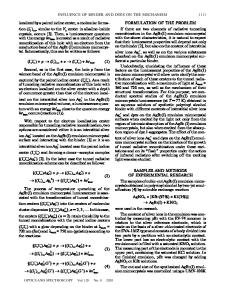Tunnel radiation in the luminescence spectra of GaN-based heterostructures
- PDF / 133,674 Bytes
- 6 Pages / 612 x 792 pts (letter) Page_size
- 8 Downloads / 301 Views
L11.4.1
Tunnel radiation in the luminescence spectra of GaN-based heterostructures A.E.Yunovich1, V.E.Kudryashov1, A.N.Turkin1, M.Leroux2, S.Dalmasso2 1 M.V.Lomonosov Moscow State University, Dept. of Physics, Vorobiovy Gory, 119899, Moscow,Russia 2 CRHEA -CNRS, Valbonne, France ABSTRACT Tunnel effects in luminescence spectra and electrical properties of LEDs based on InGaN/GaN-heterostructures made by different technological groups were studied. The tunnel radiation in a spectral region of 1.9 - 2.7 eV predominates at low currents (J E0, the (hωmax – eU) value is negative. The maximum hωmax is equal to eU at kT = (1/3)⋅E0 [5]. If we use E0 equal to 0.07÷ 0.08 eV, hωmax = eU at room temperature, kT = 0.026 meV, in good agreement with the results in Fig. 5. 5. The theoretical evaluations of the electric field in the structures do not take into account inhomogeneities in heterojunctions and potential fluctuations caused by InGaN composition fluctuations. Tunnelling is more probable in “hot points” with maximal electric fields. The tunnel band in [8, 9] was seen in the samples with the lower quantum efficiency. We have interpreted this fact as caused by nonradiative tunnel currents due to inhomogeneities in the samples with lower quantum efficiency. We have studied the luminescent spectra of the high efficiency LEDs grown in LumiLeds laboratories and could not find a tunnel radiation band at low currents [11]. These samples had multiple quantum wells modulated doped by Si donors in the barriers, not in the wells. Electrons from the donors screen polarization fields in these structures. These data confirm the model shown in Fig. 7 in which diagonal tunneling is more probable due to higher electric fields in barriers caused by polarization. 6. It is interesting to compare the results on GaN- based structures with older results of tunnel radiation studies in other (cubic) AIIIBV semiconductors: GaAs [5], InP [5], GaSb [5, 16] and (Ga,In)Sb [17]. A plot of hωmax versus U (Fig. 8) gives an excellent result: the experimental points in a wide range from the infrared to violet region are situated with a good accuracy on the theoretical line hωmax = eU. This is a proof that tunnel radiative recombination (diagonal tunneling) is a fundamental phenomenon for homo- and hetero- p-n junctions in direct gap AIIIBV semiconductors.
L11.4.6
CONCLUSIONS Tunnel radiative recombination (diagonal tunnelling), an effect inverse to the Franz – Keldysh effect, is essential in GaN-based p-n- heterojunctions with quantum wells at low currents in high electric fields (E = (0.2÷1)·106 V/cm). The probability of this effect is higher if piezoelectric and spontaneous polarization fields play a sufficient role in the AlGaN/InGaN heterojunctions. The experimental electroluminescence spectra of GaN based LEDs at low currents are described by the theory of tunnel radiation. The parameter E0 of the theory determined from the spectral fitting is higher than the one determined from the dependence of the integral intensity versus voltage. This is describ
Data Loading...










